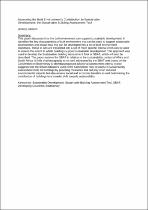 ResearchSpace
ResearchSpace
Assessing the built environment’s contribution to sustainable development: the sustainable building assessment tool
JavaScript is disabled for your browser. Some features of this site may not work without it.
- ResearchSpace
- →
- Research Publications/Outputs
- →
- Conference Publications
- →
- View Item
| dc.contributor.author |
Gibberd, Jeremy T

|
|
| dc.date.accessioned | 2016-08-19T08:11:11Z | |
| dc.date.available | 2016-08-19T08:11:11Z | |
| dc.date.issued | 2011-10 | |
| dc.identifier.citation | Gibberd, J.T. 2011. Assessing the built environment’s contribution to sustainable development: the sustainable building assessment tool. In:World Sustainable Building Conference, 18-21 October 2011, Helsinki, Finland, 13pp | en_US |
| dc.identifier.uri | Non available | |
| dc.identifier.uri | http://hdl.handle.net/10204/8706 | |
| dc.description | Copyright: 2011 World Sustainable Building Conference. Due to copyright restrictions, the attached PDF file only contains the abstract of the full text item. For access to the full text item, please consult the publisher's website. | en_US |
| dc.description.abstract | This paper discusses how the built environment can support sustainable development. It identifies the key characteristics of built environment that can be used to support sustainable development and shows how this can be developed into a set of built environment objectives. These in turn are translated into a set of more specific criteria which can be used to assess the extent to which buildings support sustainable development. This approach was used to develop the Sustainable Building Assessment Tool or SBAT, which will also be described. The paper reviews the SBAT in relation to the sustainability context of Africa and South Africa. It finds that biocapacity is not well addressed by the SBAT and draws on the Convention on Biodiversity to develop proposed additional assessment criteria. It also suggests that the linked indicators used in the Convention may be useful in sustainability assessment tools for buildings by providing measures that not only chart reduced environmental impacts but also assess social and economic benefits as well determining the contribution of buildings to a broader shift towards sustainability. | en_US |
| dc.language.iso | en | en_US |
| dc.relation.ispartofseries | Worklist;8264 | |
| dc.subject | Sustainable development | en_US |
| dc.subject | Sustainable building assessment tool | en_US |
| dc.subject | SBAT | en_US |
| dc.subject | Developing countries | en_US |
| dc.subject | Biodiversity | en_US |
| dc.title | Assessing the built environment’s contribution to sustainable development: the sustainable building assessment tool | en_US |
| dc.type | Conference Presentation | en_US |
| dc.identifier.apacitation | Gibberd, J. T. (2011). Assessing the built environment’s contribution to sustainable development: the sustainable building assessment tool. http://hdl.handle.net/10204/8706 | en_ZA |
| dc.identifier.chicagocitation | Gibberd, Jeremy T. "Assessing the built environment’s contribution to sustainable development: the sustainable building assessment tool." (2011): http://hdl.handle.net/10204/8706 | en_ZA |
| dc.identifier.vancouvercitation | Gibberd JT, Assessing the built environment’s contribution to sustainable development: the sustainable building assessment tool; 2011. http://hdl.handle.net/10204/8706 . | en_ZA |
| dc.identifier.ris | TY - Conference Presentation AU - Gibberd, Jeremy T AB - This paper discusses how the built environment can support sustainable development. It identifies the key characteristics of built environment that can be used to support sustainable development and shows how this can be developed into a set of built environment objectives. These in turn are translated into a set of more specific criteria which can be used to assess the extent to which buildings support sustainable development. This approach was used to develop the Sustainable Building Assessment Tool or SBAT, which will also be described. The paper reviews the SBAT in relation to the sustainability context of Africa and South Africa. It finds that biocapacity is not well addressed by the SBAT and draws on the Convention on Biodiversity to develop proposed additional assessment criteria. It also suggests that the linked indicators used in the Convention may be useful in sustainability assessment tools for buildings by providing measures that not only chart reduced environmental impacts but also assess social and economic benefits as well determining the contribution of buildings to a broader shift towards sustainability. DA - 2011-10 DB - ResearchSpace DP - CSIR KW - Sustainable development KW - Sustainable building assessment tool KW - SBAT KW - Developing countries KW - Biodiversity LK - https://researchspace.csir.co.za PY - 2011 T1 - Assessing the built environment’s contribution to sustainable development: the sustainable building assessment tool TI - Assessing the built environment’s contribution to sustainable development: the sustainable building assessment tool UR - http://hdl.handle.net/10204/8706 ER - | en_ZA |





